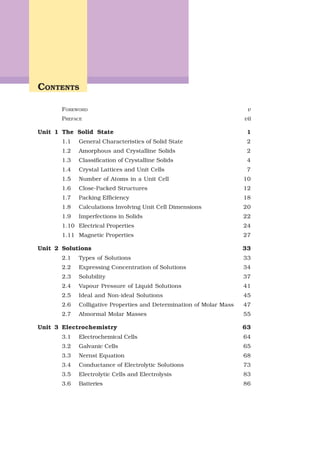Contents
- 1. CONTENTS FOREWORD v PREFACE vii Unit 1 The Solid State 1 1.1 General Characteristics of Solid State 2 1.2 Amorphous and Crystalline Solids 2 1.3 Classification of Crystalline Solids 4 1.4 Crystal Lattices and Unit Cells 7 1.5 Number of Atoms in a Unit Cell 10 1.6 Close-Packed Structures 12 1.7 Packing Efficiency 18 1.8 Calculations Involving Unit Cell Dimensions 20 1.9 Imperfections in Solids 22 1.10 Electrical Properties 24 1.11 Magnetic Properties 27 Unit 2 Solutions 33 2.1 Types of Solutions 33 2.2 Expressing Concentration of Solutions 34 2.3 Solubility 37 2.4 Vapour Pressure of Liquid Solutions 41 2.5 Ideal and Non-ideal Solutions 45 2.6 Colligative Properties and Determination of Molar Mass 47 2.7 Abnormal Molar Masses 55 Unit 3 Electrochemistry 63 3.1 Electrochemical Cells 64 3.2 Galvanic Cells 65 3.3 Nernst Equation 68 3.4 Conductance of Electrolytic Solutions 73 3.5 Electrolytic Cells and Electrolysis 83 3.6 Batteries 86
- 2. 3.7 Fuel Cells 88 3.8 Corrosion 89 Unit 4 Chemical Kinetics 93 4.1 Rate of a Chemical Reaction 94 4.2 Factors Influencing Rate of a Reaction 98 4.3 Integrated Rate Equations 103 4.4 Pseudo First Order Reaction 110 4.5 Temperature Dependence of the Rate of a Reaction 111 4.6 Collision Theory of Chemical Reactions 115 Unit 5 Surface Chemistry 121 5.1 Adsorption 122 5.2 Catalysis 127 5.3 Colloids 134 5.4 Classification of Colloids 134 5.5 Emulsions 143 5.6 Colloids Around Us 143 Unit 6 General Principles and Processes of Isolation of Elements 147 6.1 Occurrence of Metals 148 6.2 Concentration of Ores 148 6.3 Extraction of Crude Metal from Concentrated Ore 150 6.4 Thermodynamic Principles of Metallurgy 151 6.5 Electrochemical Principles of Metallurgy 157 6.6 Oxidation Reduction 158 6.7 Refining 159 6.8 Uses of Aluminium, Copper, Zinc and Iron 162 Unit 7 The p-Block Elements 165 7.1 Group 15 Elements 165 7.2 Dinitrogen 169 7.3 Ammonia 170 7.4 Oxides of Nitrogen 172 7.5 Nitric Acid 173 7.6 Phosphorus â Allotropic Forms 175 7.7 Phosphine 176 7.8 Phosphorus Halides 177 7.9 Oxoacids of Phosphorus 178 xiv
- 3. 7.10 Group 16 Elements 180 7.11 Dioxygen 184 7.12 Simple Oxides 185 7.13 Ozone 185 7.14 Sulphur â Allotropic Forms 187 7.15 Sulphur Dioxide 188 7.16 Oxoacids of Sulphur 189 7.17 Sulphuric Acid 189 7.18 Group 17 Elements 192 7.19 Chlorine 197 7.20 Hydrogen Chloride 198 7.21 Oxoacids of Halogens 199 7.22 Interhalogen Compounds 200 7.23 Group 18 Elements 202 Unit 8 The d-and f-Block Elements 209 8.1 Position in the Periodic Table 210 8.2 Electronic Configurations of the d-Block Elements 210 8.3 General Properties of the Transition Elements (d-Block) 212 8.4 Some important Compounds of Transition Elements 224 8.5 The Lanthanoids 227 8.6 The Actinoids 230 8.7 Some Applications of d-and f-Block Elements 232 Unit 9 Coordination Compounds 237 9.1 Werner's Theory of Coordination Compounds 237 9.2 Definition of Some Important Terms Pertaining to 240 Coordination Compounds 9.3 Nomenclature of Coordination Compounds 241 9.4 Isomerism in Coordination Compounds 244 9.5 Bonding in Coordination Compounds 247 9.6 Bonding in Metal Carbonyls 254 9.7 Stability of Coordination Compounds 255 9.8 Importance and Applications of Coordination 256 Compounds Appendices 261 Answers to Some Questions in Exercises 274 Index 278 xv


